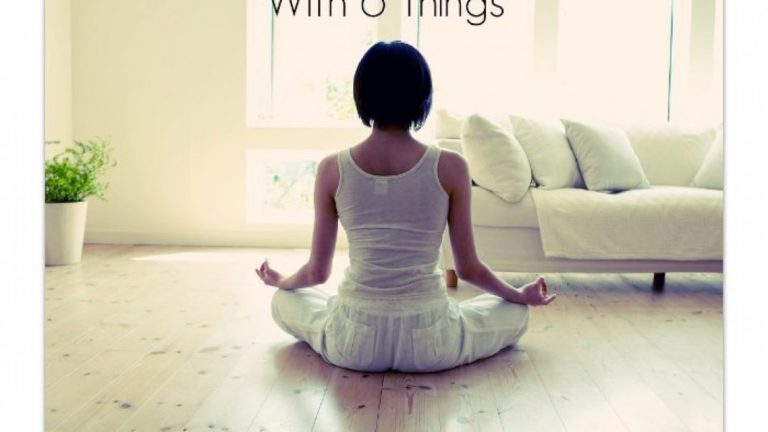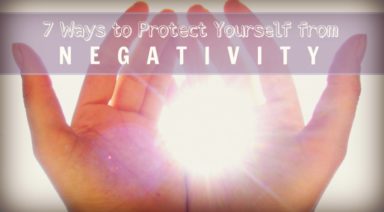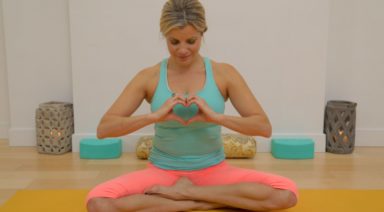These 6 things add serenity to any room in your house

We could all use a little more Zen in the place where we rest, recharge, and refocus: our homes! Now that you’ve detoxified your house, Feng Shui’d it up, and put it through the spring cleaning wringer, you can take a deep breath and find a little more peace in your home life with these tips, thanks to Oprah Magazine. The best part is that you can do these things in any room that you think could use more positive vibes, whether it’s your bedroom, your living room, or your dining room!
A Noise-Canceling…Rug
You probably never even noticed a spa’s greatest trick for creating a calming environment: “Soft fabrics, like mohair, help keep sounds from echoing,” says Stacy Shoemaker, editor-in-chief of Hospitality Design, which recognizes the world’s top hotels with its annual design awards. White sheepskin throws, rugs and covered pillows are especially popular right now: They’ve got all the plushness of a high-end fabric, but—starting at about $30 a piece—they won’t kill your budget.
An Odd Couple That Works Together
In a room with a mishmash of furniture bought, given and handed down, one of the easiest ways to keep things from looking jumbled is to figure out which pieces of furniture could work together—like a mirror and a chest that form a makeshift vanity—and paint them the same color, designer and The Nesting Place author Myquillyn Smith says.
A Signature Scent
Le Méridien commissioned a custom scent for its rooms, which smells a lot like leather-bound books. It’s familiar enough to comfort guests, and distinctive enough that they’ll associate it only with the hotel. Similarly, having a nontraditional scent that reminds you of your home—and only your home—can help you leave work, traffic jams and that rude woman at the grocery store behind as soon as you walk through the door.
A Bright Spot
Oh, to have gigantic windows and skylights. That may not be the reality for most of us, but with a few extra lamps—including an overhead light set to a dimmer switch—and boosting the lights so they’re brightest at mid-day, when the sun is at its brightest, could help you feel better (and create a home that looks like this). An October 2013 study in the Journal of Advanced Nursing found that hospital patients who were exposed to low levels of light 24 hours a day were more fatigued and reported higher pain levels than those who stayed in rooms with lights that adjusted. With just 40 people surveyed, there’s no guarantee that brighter days and darker evenings will improve your health, but it may be worth testing out for yourself.
A Glimmer of Warmth
While soft blues continue to be the most popular “peaceful” color, Zillow Digs’s Board of Designers survey found that a new shade has tied white for the number two spot: Gray. Unlike other calming colors, which tend to be cool tones, most people prefer light grays that have hints of red in them. Cool grays feel sterile, like an industrial warehouse, explains Jackie Jordan, director of color marketing at Sherwin-Williams. She recommends Mindful Gray or Anew Gray, and says she’s seeing them paired with pale aquas as an alternative to the classic blue and white.
Find Your Center
Start with the biggest piece of furniture in the room–that’s where your gaze will naturally rest. Flank it with two similar items, like a pair of side tables, wall art or lamps–but not pairs of all three, or you risk veering from symmetry to “sameness.” Because you’re going for serenity, not boredom.
Dr. Bradley Nelson On How to Break Down Our Heart Walls

After the year of a global pandemic, more people are experiencing levels of depression and anxiety than ever before.
A recent episode of “Open Minds” with Regina Meredith, explores our subconscious response to the past year’s tribulations in a conversation with Dr. Bradley Nelson, author of “The Emotion Code,” and the forthcoming book “The Body Code.” The two discuss Nelson’s work breaking down our “heart walls,” helping us to live with more joy, connection, and vibrational health, while also allowing us to thrive in difficult times.
Overwriting Negative Tendencies in Our Subconscious
The past year’s collective experience opened new insights into our innate need for connection and belonging. “We’re designed to be together,” Dr. Nelson explains. “We’re not designed to be apart.”
Nelson explains that the unfamiliar landscape we’ve been living in has resulted in our bodies shutting down, especially if there is already a tendency to bury intense and overwhelming emotions. He believes more people are now forming what he refers to as “heart walls,” a protective energy field around the heart, the organ Nelson defines as being “the seat of the soul, the source of love and creativity…the seed of the subconscious.”
Composed of mostly nervous tissue, scientists and holistic practitioners alike have viewed the heart as being another brain. Nelson shares that the majority of the messages between the heart and the brain are sent from the heart. With the amount of continuous stress, worry, or grief over lost loved ones, the heart’s response is one of feeling broken or being in extreme danger. In response, the heart erects a “wall” around it to protect our essential self — the heart wall.
Nelson explains that while this stress response is appropriate during times of crisis when the heart moves into a bunker, the heart wall pattern can live on after things have returned to “normal.” These protective layers, after a crisis has passed, can make it difficult for us to live in health or to give and receive love and affection—a basic function that is key to living our full potential.
Nelson’s work to help people break down the heart wall has had significant and positive impacts on suicidally depressed people. He believes that breaking the heart wall down is the most important work that any of us can do and is accessible by simply tuning into our subconscious self and ability to love.





































